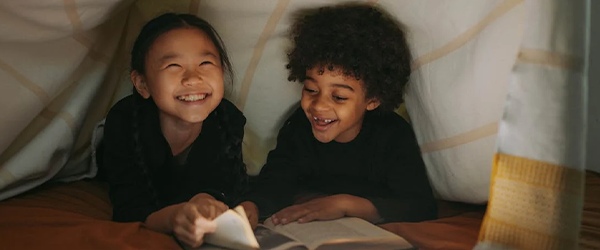How bilingual education works
4 minute readThe first words a child speaks are magical. Witnessing their journey of discovery, from navigating their world to expressing themselves, is truly something special. This journey becomes even more exciting when they embark on learning a second language.
Our bilingual picture dictionary, “My 100 Words,” makes language learning fun for your little ones. Developed in collaboration with Dr. Stephanie Wermelinger, a developmental psychologist at the University of Zurich, it provides everything you need to support your child’s bilingual development in the best way possible.
Tips for bilingual education
1. Start their learning as early as possible
Start speaking to your child in your mother tongue at an early age.
The earlier children start learning a language, the greater the likelihood that they will master the language at native speaker level.
Research shows infants as young as one year old can distinguish between languages. Earlier exposure to various languages allows them to effortlessly absorb the sounds, structure, and nuances of each language. While early exposure offers a significant head start, an MIT study revealed a fascinating truth: children retain the potential to acquire a second language at a native level well into their teenage years, up to the age of 18. However, this potential does decrease after the age of ten. This suggests a critical window for maximizing language learning abilities, though even teenagers can achieve impressive fluency with dedicated effort they tend to struggle slightly more than children who’ve been immersed in multiple languages from an earlier age. [2]
2. The linguistic environment is important
No matter who they interact with, offer your child ample opportunities to communicate in your native tongue. Research suggests that achieving native-level fluency thrives in a language rich environment, where exposure goes beyond just one person [3]. For example, a child encountering different native speakers’ diverse use of language, such as grandparents using different terms for the same thing, siblings using slang and so on, fuels their language acquisition, helping them understand the nuances and flexibility of your language.
3. The quality of the linguistic input is important
Speak to the child in the language in which you are most competent.
Studies have shown that it’s not just about how often you speak to the child. It also depends on the quality of the language used. The more competent the speaking parent is in their own language, the better the child’s language skills will be [4].

4. Consistency is key!
Remember, consistency is crucial! The more you communicate with your child in your mother tongue, the faster they’ll develop fluency. This doesn’t require them to use it everywhere, but consistent exposure at home lays a strong foundation [5].
Think of it as planting a seed – with regular care and watering (speaking your language!), it blossoms into a lifelong gift of bilingualism. Even if they don’t use it all the time now, the foundation you build will ensure they can easily reactivate this skill later in life.

5. Make your language influence as interactive as possible!
We all know the allure of screen time when we’re busy and need some peace and quiet, but when it comes to language development, interaction wins the day! Whilst Television offers limited benefits, reading together fosters a dynamic language environment [3]. Instead, language influence should be as interactive as possible. Reading books together offers particularly valuable support here when it comes to language acquisition. Ask questions, discuss the illustrations, and encourage participation [6]. This interactive process isn’t just fun; it’s a powerful tool that helps your child actively engage with language.
You can find more interesting information on bilingualism in this blog article.
Our bilingual picture dictionary
With “My 100 Words” we celebrate the wonderful bilingual world of words! The book takes the child on an exciting journey through the seasons. As they explore different objects, colors, and more, they’ll playfully expand their vocabulary in two languages!
Our picture dictionary is designed to enable children to expand their vocabulary with ease and enjoyment. The colourful illustrations help children to remember individual words faster and better – because even small children can decode and absorb pictures intuitively. If pictures are combined with new words, they form a unit for the child, which they can process and memorise even faster[7].
[1] Vgl. Hoff 2015: 485f.
[2] Vgl. Hartsthorne 2018: 263ff.
[3] Vgl. Hoff 2015: 494.
[4] Vgl. Hoff 2015: 498f.
[5] Vgl. De Hower 2007: 419ff.; vgl. auch Kohnert 2002: 352ff.
[6] Vgl. De Houwer 2007: 421.
[7] Vgl. Strauber 2020: 6; vgl. auch Van der Bijl 2006: 44.
Sources
De Hower, A.: Parental language input patterns and children’s bilingual use. In: Applied Psycholinguistics 28/3 (2007): 411-424.
Hartshorne J. K. et al.: A critical period for second language acquisition: Evidence from 2/3 million English speakers. In: Cognition. International Journal of Cognitive Science 177 (2018): 263-277.
Hoff, E.: Language development in bilingual children. In: E. L. Bavin and L, R. Naigles (eds): The Cambridge Handbook of Child Language. Cambridge Handbooks in Language and Linguistics. Cambridge (2015): 483-503.
Strauber, B. C. et al.: Using a picture-embedded method to support acquisition of sight word. In: Journal of the European Association for Research on Learning and Instruction 65 (2020): 1-8.






